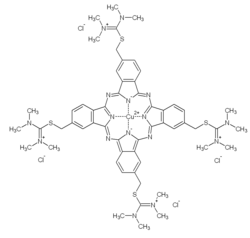
| |
| Names | |
|---|---|
| Other names
Alcian blue 8GX, Ingrain blue 1, C.I. 74240, "chloromethylated copper phthalocyanine-thiourea reaction products"
| |
| Identifiers | |
3D model (JSmol)
|
|
| ChemSpider | |
| ECHA InfoCard | 100.046.990 |
PubChem CID
|
|
| UNII | |
CompTox Dashboard (EPA)
|
|
| |
| |
| Properties | |
| C56H68Cl4CuN16S4 | |
| Molar mass | 1298.86 g·mol−1 |
Except where otherwise noted, data are given for materials in their standard state (at 25 °C [77 °F], 100 kPa).
| |

Alcian blue (/ˈælʃən/) is any member of a family of polyvalent basic dyes, of which the Alcian blue 8G (also called Ingrain blue 1, and C.I. 74240, formerly called Alcian blue 8GX from the name of a batch of an ICI product) has been historically the most common and the most reliable member.[1] It is used to stain acidic polysaccharides such as glycosaminoglycans in cartilages and other body structures, some types of mucopolysaccharides, sialylated glycocalyx of cells etc. For many of these targets it is one of the most widely used cationic dyes for both light and electron microscopy. Use of alcian blue has historically been a popular staining method in histology especially for light microscopy in paraffin embedded sections and in semithin resin sections. The tissue parts that specifically stain by this dye become blue to bluish-green after staining and are called "Alcianophilic" (comparable to "eosinophilic" or "sudanophilic"). Alcian blue staining can be combined with H&E staining, PAS staining and van Gieson staining methods. Alcian blue can be used to quantitate acidic glycans both in microspectrophotometric quantitation in solution or for staining glycoproteins in polyacrylamide gels or on western blots. Biochemists had used it to assay acid polysaccharides in urine since the 1960s for diagnosis of diseases like mucopolysaccharidosis but from 1970's, partly due to lack of availability of Alcian and partly due to length and tediousness of the procedure, alternative methods had to be developed e.g. Dimethyl methylene blue (DMB or DMMB) method.[2]
John E. Scott, the first person outside the dye industry to crack the chemical secret of this dye, comments:
- "Probably no other dyestuff has been applied to such wide variety of problems in biology and medicine. On the other hand, no other dyestuff had such a chequered history as AB.[3]"
In addition to its wide use as a stain, Alcian blue has also been used in other diverse applications e.g. gelling agent for lubricating fluids, modifiers for electrodes, charged coating agents etc.

- ^ Hayat, M. A. (31 March 1993). Stains and Cytochemical Methods. Springer Science & Business Media. ISBN 9780306442940 – via Google Books.
- ^ Clinical Chemistry March 1989 vol. 35 no. 3 374–379
- ^ Scott John E (1996). "Alcian blue. Now you see it, now you don't". European Journal of Oral Sciences. 104 (1): 2–9. doi:10.1111/j.1600-0722.1996.tb00038.x. PMID 8653492.